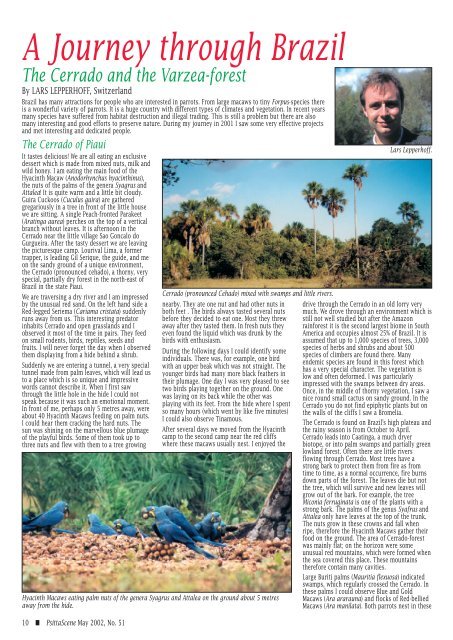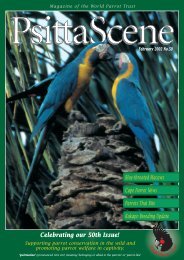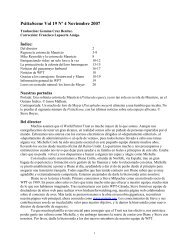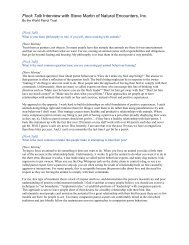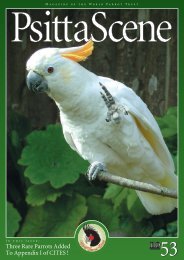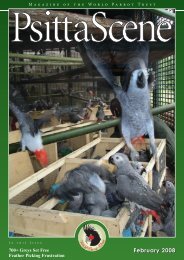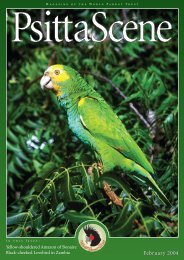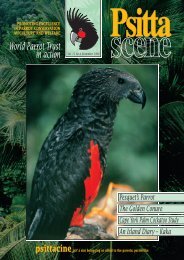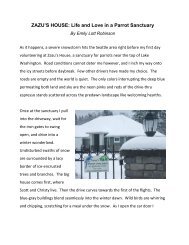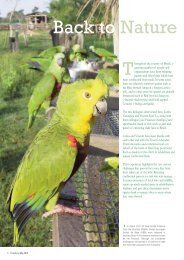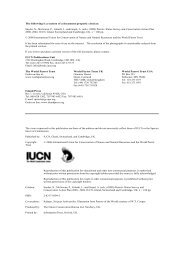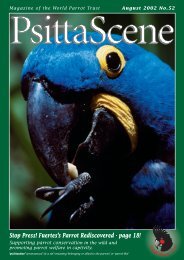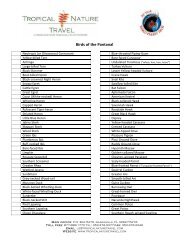Parrots in the Wild - World Parrot Trust
Parrots in the Wild - World Parrot Trust
Parrots in the Wild - World Parrot Trust
Create successful ePaper yourself
Turn your PDF publications into a flip-book with our unique Google optimized e-Paper software.
A Journey through Brazil<br />
The Cerrado and <strong>the</strong> Varzea-forest<br />
By LARS LEPPERHOFF, Switzerland<br />
Brazil has many attractions for people who are <strong>in</strong>terested <strong>in</strong> parrots. From large macaws to t<strong>in</strong>y Forpus-species <strong>the</strong>re<br />
is a wonderful variety of parrots. It is a huge country with different types of climates and vegetation. In recent years<br />
many species have suffered from habitat destruction and illegal trad<strong>in</strong>g. This is still a problem but <strong>the</strong>re are also<br />
many <strong>in</strong>terest<strong>in</strong>g and good efforts to preserve nature. Dur<strong>in</strong>g my journey <strong>in</strong> 2001 I saw some very effective projects<br />
and met <strong>in</strong>terest<strong>in</strong>g and dedicated people.<br />
The Cerrado of Piaui<br />
It tastes delicious! We are all eat<strong>in</strong>g an exclusive<br />
dessert which is made from mixed nuts, milk and<br />
wild honey. I am eat<strong>in</strong>g <strong>the</strong> ma<strong>in</strong> food of <strong>the</strong><br />
Hyac<strong>in</strong>th Macaw (Anodorhynchus hyac<strong>in</strong>th<strong>in</strong>us),<br />
<strong>the</strong> nuts of <strong>the</strong> palms of <strong>the</strong> genera Syagrus and<br />
Attalea! It is quite warm and a little bit cloudy.<br />
Guira Cuckoos (Cuculus guira) are ga<strong>the</strong>red<br />
gregariously <strong>in</strong> a tree <strong>in</strong> front of <strong>the</strong> little house<br />
we are sitt<strong>in</strong>g. A s<strong>in</strong>gle Peach-fronted Parakeet<br />
(Arat<strong>in</strong>ga aurea) perches on <strong>the</strong> top of a vertical<br />
branch without leaves. It is afternoon <strong>in</strong> <strong>the</strong><br />
Cerrado near <strong>the</strong> little village Sao Goncalo do<br />
Gurgueira. After <strong>the</strong> tasty dessert we are leav<strong>in</strong>g<br />
<strong>the</strong> picturesque camp. Lourival Lima, a former<br />
trapper, is lead<strong>in</strong>g Gil Serique, <strong>the</strong> guide, and me<br />
on <strong>the</strong> sandy ground of a unique environment,<br />
<strong>the</strong> Cerrado (pronounced cehado), a thorny, very<br />
special, partially dry forest <strong>in</strong> <strong>the</strong> north-east of<br />
Brazil <strong>in</strong> <strong>the</strong> state Piaui.<br />
We are travers<strong>in</strong>g a dry river and I am impressed<br />
by <strong>the</strong> unusual red sand. On <strong>the</strong> left hand side a<br />
Red-legged Seriema (Cariama cristata) suddenly<br />
runs away from us. This <strong>in</strong>terest<strong>in</strong>g predator<br />
<strong>in</strong>habits Cerrado and open grasslands and I<br />
observed it most of <strong>the</strong> time <strong>in</strong> pairs. They feed<br />
on small rodents, birds, reptiles, seeds and<br />
fruits. I will never forget <strong>the</strong> day when I observed<br />
<strong>the</strong>m display<strong>in</strong>g from a hide beh<strong>in</strong>d a shrub.<br />
Suddenly we are enter<strong>in</strong>g a tunnel, a very special<br />
tunnel made from palm leaves, which will lead us<br />
to a place which is so unique and impressive<br />
words cannot describe it. When I first saw<br />
through <strong>the</strong> little hole <strong>in</strong> <strong>the</strong> hide I could not<br />
speak because it was such an emotional moment.<br />
In front of me, perhaps only 5 metres away, were<br />
about 40 Hyac<strong>in</strong>th Macaws feed<strong>in</strong>g on palm nuts.<br />
I could hear <strong>the</strong>m crack<strong>in</strong>g <strong>the</strong> hard nuts. The<br />
sun was sh<strong>in</strong><strong>in</strong>g on <strong>the</strong> marvellous blue plumage<br />
of <strong>the</strong> playful birds. Some of <strong>the</strong>m took up to<br />
three nuts and flew with <strong>the</strong>m to a tree grow<strong>in</strong>g<br />
10 ■ PsittaScene May 2002, No. 51<br />
Cerrado (pronounced Cehado) mixed with swamps and little rivers.<br />
nearby. They ate one nut and had o<strong>the</strong>r nuts <strong>in</strong><br />
both feet . The birds always tasted several nuts<br />
before <strong>the</strong>y decided to eat one. Most <strong>the</strong>y threw<br />
away after <strong>the</strong>y tasted <strong>the</strong>m. In fresh nuts <strong>the</strong>y<br />
even found <strong>the</strong> liquid which was drunk by <strong>the</strong><br />
birds with enthusiasm.<br />
Dur<strong>in</strong>g <strong>the</strong> follow<strong>in</strong>g days I could identify some<br />
<strong>in</strong>dividuals. There was, for example, one bird<br />
with an upper beak which was not straight. The<br />
younger birds had many more black fea<strong>the</strong>rs <strong>in</strong><br />
<strong>the</strong>ir plumage. One day I was very pleased to see<br />
two birds play<strong>in</strong>g toge<strong>the</strong>r on <strong>the</strong> ground. One<br />
was lay<strong>in</strong>g on its back while <strong>the</strong> o<strong>the</strong>r was<br />
play<strong>in</strong>g with its feet. From <strong>the</strong> hide where I spent<br />
so many hours (which went by like five m<strong>in</strong>utes)<br />
I could also observe T<strong>in</strong>amous.<br />
After several days we moved from <strong>the</strong> Hyac<strong>in</strong>th<br />
camp to <strong>the</strong> second camp near <strong>the</strong> red cliffs<br />
where <strong>the</strong>se macaws usually nest. I enjoyed <strong>the</strong><br />
Hyac<strong>in</strong>th Macaws eat<strong>in</strong>g palm nuts of <strong>the</strong> genera Syagrus and Attalea on <strong>the</strong> ground about 5 metres<br />
away from <strong>the</strong> hide.<br />
Lars Lepperhoff.<br />
drive through <strong>the</strong> Cerrado <strong>in</strong> an old lorry very<br />
much. We drove through an environment which is<br />
still not well studied but after <strong>the</strong> Amazon<br />
ra<strong>in</strong>forest it is <strong>the</strong> second largest biome <strong>in</strong> South<br />
America and occupies almost 25% of Brazil. It is<br />
assumed that up to 1,000 species of trees, 3,000<br />
species of herbs and shrubs and about 500<br />
species of climbers are found <strong>the</strong>re. Many<br />
endemic species are found <strong>in</strong> this forest which<br />
has a very special character. The vegetation is<br />
low and often deformed. I was particularly<br />
impressed with <strong>the</strong> swamps between dry areas.<br />
Once, <strong>in</strong> <strong>the</strong> middle of thorny vegetation, I saw a<br />
nice round small cactus on sandy ground. In <strong>the</strong><br />
Cerrado you do not f<strong>in</strong>d epiphytic plants but on<br />
<strong>the</strong> walls of <strong>the</strong> cliffs I saw a Bromelia.<br />
The Cerrado is found on Brazil’s high plateau and<br />
<strong>the</strong> ra<strong>in</strong>y season is from October to April.<br />
Cerrado leads <strong>in</strong>to Caat<strong>in</strong>ga, a much dryer<br />
biotope, or <strong>in</strong>to palm swamps and partially green<br />
lowland forest. Often <strong>the</strong>re are little rivers<br />
flow<strong>in</strong>g through Cerrado. Most trees have a<br />
strong bark to protect <strong>the</strong>m from fire as from<br />
time to time, as a normal occurrence, fire burns<br />
down parts of <strong>the</strong> forest. The leaves die but not<br />
<strong>the</strong> tree, which will survive and new leaves will<br />
grow out of <strong>the</strong> bark. For example, <strong>the</strong> tree<br />
Miconia ferrug<strong>in</strong>ata is one of <strong>the</strong> plants with a<br />
strong bark. The palms of <strong>the</strong> genus Syafrus and<br />
Attalea only have leaves at <strong>the</strong> top of <strong>the</strong> trunk.<br />
The nuts grow <strong>in</strong> <strong>the</strong>se crowns and fall when<br />
ripe, <strong>the</strong>refore <strong>the</strong> Hyac<strong>in</strong>th Macaws ga<strong>the</strong>r <strong>the</strong>ir<br />
food on <strong>the</strong> ground. The area of Cerrado-forest<br />
was ma<strong>in</strong>ly flat; on <strong>the</strong> horizon were some<br />
unusual red mounta<strong>in</strong>s, which were formed when<br />
<strong>the</strong> sea covered this place. These mounta<strong>in</strong>s<br />
<strong>the</strong>refore conta<strong>in</strong> many cavities.<br />
Large Buriti palms (Mauritia flexuosa) <strong>in</strong>dicated<br />
swamps, which regularly crossed <strong>the</strong> Cerrado. In<br />
<strong>the</strong>se palms I could observe Blue and Gold<br />
Macaws (Ara ararauna) and flocks of Red-bellied<br />
Macaws (Ara manilata). Both parrots nest <strong>in</strong> <strong>the</strong>se


